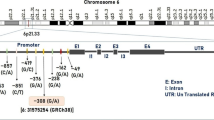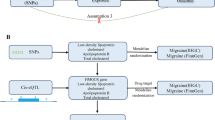Abstract
Background
Apolipoprotein E (ApoE) gene has been reported to be associated with migraine and tension-type headache (TTH), but the results are conflicting. This study aimed to evaluate the association of ApoE with migraine by a meta-analysis.
Methods
MEDLINE, ISI Web of Knowledge, The Cochrane Central Register of Controlled Trials, and EMBASE databases were searched to identify eligible studies published in English from 2000 to 2014. Data were extracted using standardized forms. The association was assessed by relative risk (RR) with 95 % confidence intervals (CIs) using a fixed or random effects model.
Results
Four studies, comprising 649 migraineurs, 229 TTH subjects and 975 controls, met all the criteria and were included in the meta-analysis. No significant difference was found comparing genotypic and allelic frequencies in the case of migraineurs versus controls and TTH subjects versus controls. Only when migraineurs and TTH subjects were considered as a whole group, ApoE4 was found to increase the relative risk of headache by 1.48 (95 % CI 1.16, 1.90; P = 0.002), compared to controls.
Conclusions
ApoE ε4 allele is not associated with migraine susceptibility, but is positively related to headache (including migraine and TTH).
Similar content being viewed by others
Background
Migraine is a common neurovascular disorder, characterized by recurrent episodes of headache and the dysfunction of the autonomic nervous system, affecting 10–20 % of the population [1, 2]. Although the pathophysiology of migraine is largely unknown, a neurogenic hypothesis of migraine has been proposed [3]. In particular, the genes involved in regulation of the endothelin system are proved to be promising candidates in migraine susceptibility [4, 5].
Apolipoprotein E (ApoE) is a 299 amino acid protein, encoded by a gene located on chromosome 19cen-q13.2 [6, 7]. ApoE gene has three common alleles (ɛ2, ɛ3, ɛ4) that encode three isoforms (APOE2, APOE3, APOE4). Several studies have shown a relationship between APOE polymorphism and the expression of the cytokines involved in migraine and TTH [8, 9]. Moreover, several studies investigated the association between APOE single nucleotide polymorphism (SNP) and migraine, but the results are conflicting [10–13].
Therefore, to define further the disease risk associated with APOE polymorphism, in this study we performed a meta-analysis of all related studies that evaluated allelic and genotypic frequencies of ApoE polymorphism in migraine.
Methods
Selection of studies
Eligible studies were identified by searching on web-based databases (MEDLINE 2000 to 2014, ISI Web of Knowledge 2000 to 2014, The Cochrane Central Register of Controlled Trials 2000 to 2014, and EMBASE) with no language restrictions. Search terms were “apolipoprotein E”, “APOE”, “ɛ2”, “ɛ3”, “ɛ4”, “APOE2”, “APOE3”, “APOE4”, “migraine”, “headache” and “Polymorphism”. Potentially relevant studies were retrieved and reviewed by 2 reviewers. All case–control studies with extractable data were included. Included studies were published as full-length articles in peer-reviewed journals.
Data extraction and quality assessment
Studies were included for meta-analysis if they met the following criteria: (1) the association between APOE and migraine was examined by using a population-based, case–control design; (2) migraine was diagnosed using an international standard; (3) genotype or allele frequencies were reported in both cases and controls; (4) the genotype frequencies in control groups were consistent with Hardy-Weinberg equilibrium.
Statistical analysis
Heterogeneity across the eligible studies was tested using Q-test, and it was considered statistically significant when P < 0.1. Heterogeneity was also quantified with I2 test (I2 = (Q− df) / Q × 100 %. I2 values of above 25 %, 50 %, and 75 % were taken as indicators of mild, modest, and high heterogeneities, respectively. When the effects were assumed to be homogeneous (P >0.1, I2 < 50 %), the fixed-effects model was used; otherwise, the random-effects model was more appropriate. The meta-analyses were performed using Stata Version 12.0 software (Stata Corp., College Station, TX, USA).
Results
Study inclusion and characteristics
As a result of our literature search, a total of four published articles reported on the relationship between APOE SNP and migraine and met the inclusion criteria. Rainero et al. divided the subjects into three subgroups: migraine with aura; migraine without aura; and mixed headaches (migraine associated with tension-type headache) [10]. Stuart et al. separated migraineurs into MA and MO groups. The other two reports investigated a possible association of APOE polymorphism with migraine and TTH [11, 12].
Results of meta-analyses
Total 649 migraineurs, 229 TTH subjects and 975 controls were genotyped for APOE polymorphism. In the four studies, the distribution of the genotypes in control groups was in Hardy–Weinberg equilibrium (P < 0.05).
No significant difference was found between genotypic and allelic frequencies in the case of migraineurs versus controls and TTH subjects versus controls. Exclusively in the comparison between subjects with the allele E2 vs. E3 + E4, pooled RR with fixed effect was 1.49 (95 % CI 1.11, 2.01; P = 0.009, I2 = 74.1 %). This significance disappeared with random effect (RR1.82; 95 %CI 0.92, 3.61). While E4 gene increased the relative risk of headache by1.48 (95 % CI 1.16, 1.90; P = 0.002), they did not show any effect when migraineurs and TTH subjects were taken as a reference category (Figs. 1 and 2).
Meta-analysis of subgroups
To determine genetic heterogeneity of E2, MO and MA subgroups were also compared vs. controls. No significant difference between cases and controls was observed (Figs. 3 and 4).
Discussion
The results of this meta-analysis suggest that there is no association between migraine and APOE polymorphism, even in subgroups analyses. However, when migraineurs and TTH subjects as a whole headache group were examined, a significant association was found between headache and E4 gene polymorphism. Migraineurs and TTH subjects carrying the allele E4, using fixed effects, showed a modest heterogeneity but significantly increased disease risk. The modest heterogeneity is the most likely explanation for the differences in ethnicity or in sample characteristics. Our data therefore partially confirm previous studies suggesting that this polymorphism represents a genetic risk factor for patients with migraine or TTH.
Nitric oxide (NO) plays an essential role in the pathogenesis of both migraine and TTH [14, 15]. Moreover, the production of NO is dependent on APOE HhaI polymorphism [16]. NO production is greater in APOE4 carriers with characteristically high levels of oxidative stress than in APOE3 carriers after closed head injury and stroke [17]. In addition, higher inflammation activity was associated with APOE ɛ4 gene compared to APOE ɛ3 gene [18]. Furthermore, APOE polymorphism influences the expression of the cytokines involved in migraine and TTH [8, 9, 19]. These results suggest that APOE4 may be associated with more serious tissue damage and higher disease susceptibility. Similarly, we found that APOE4 increased the relatively higher risk of headache compared to APOE3.
There are some limitations in our study. First, since migraine is a complex and heterogeneous disorder with a wide clinical spectrum, patients with different clinical phenotypes may not sufficiently capture this variability and may result in misclassification. Second, we only chose three genotypes in our study, despite various genotypes of APOE. Third, the lack of individual data has restricted further adjustments for the subgroup analysis for TTH. Fourth, the analysis was performed on a relatively small number of retrospective case–control studies, and the subjects included in these studies are also limited. Further population-based studies with larger sample size are necessary to confirm our conclusions.
Conclusions
In summary, the evidence from the present meta-analysis showed that APOE4 is not associated with migraine or TTH, but is related to headache (including migraine and TTH), suggesting a nonspecific role for the risk of headache.
References
Silberstein SD. Migraine. Lancet. 2004;363(9406):381–91.
Haut SR, Bigal ME, Lipton RB. Chronic disorders with episodic manifestations: focus on epilepsy and migraine. Lancet Neurol. 2006;5(2):148–57.
Pietrobon D, Striessnig J. Neurobiology of migraine. Nat Rev Neurosci. 2003;4(5):386–98.
Moskowitz MA. Pathophysiology of headache--past and present. Headache. 2007;47 Suppl 1:S58–63.
Lemos C, Neto JL, Pereira-Monteiro J, Mendonca D, Barros J, Sequeiros J, et al. A role for endothelin receptor type A in migraine without aura susceptibility? A study in Portuguese patients. Eur J Neurol. 2011;18(4):649–55.
Lynch JR, Morgan D, Mance J, Matthew WD, Laskowitz DT. Apolipoprotein E modulates glial activation and the endogenous central nervous system inflammatory response. J Neuroimmunol. 2001;114(1-2):107–13.
Kaur M, Balgir PP. APOE2 and consanguinity: a risky combination for Alzheimer's disease. J Alzheimers Dis. 2005;8(3):293–7.
Perini F, D'Andrea G, Galloni E, Pignatelli F, Billo G, Alba S, et al. Plasma cytokine levels in migraineurs and controls. Headache. 2005;45(7):926–31.
Tsoi LM, Wong KY, Liu YM, Ho YY. Apoprotein E isoform-dependent expression and secretion of pro-inflammatory cytokines TNF-alpha and IL-6 in macrophages. Arch Biochem Biophys. 2007;460(1):33–40.
Rainero I, Grimaldi LM, Salani G, Valfre W, Savi L, Rivoiro C, et al. Apolipoprotein E gene polymorphisms in patients with migraine. Neurosci Lett. 2002;317(2):111–3.
Joshi G, Pradhan S, Mittal B. Vascular gene polymorphisms (EDNRA -231 G > A and APOE HhaI) and risk for migraine. DNA Cell Biol. 2011;30(8):577–84.
Gupta R, Kumar V, Luthra K, Banerjee B, Bhatia MS. Polymorphism in apolipoprotein E among migraineurs and tension-type headache subjects. J Headache Pain. 2009;10(2):115–20.
Stuart S, Donges B, Murrell M, Haupt LM, Lea RA, Griffiths LR. Investigation of APOE isoforms and the association between APOE E3 and E4 with migraine in the Australian Caucasian population. Neuroreport. 2013;24(10):499–503.
Olesen J, Thomsen LL, Lassen LH, Olesen IJ. The nitric oxide hypothesis of migraine and other vascular headaches. Cephalalgia. 1995;15(2):94–100.
Ashina M. Neurobiology of chronic tension-type headache. Cephalalgia. 2004;24(3):161–72.
Czapiga M, Colton CA. Microglial function in human APOE3 and APOE4 transgenic mice: altered arginine transport. J Neuroimmunol. 2003;134(1-2):44–51.
Colton CA, Brown CM, Cook D, Needham LK, Xu Q, Czapiga M, et al. APOE and the regulation of microglial nitric oxide production: a link between genetic risk and oxidative stress. Neurobiol Aging. 2002;23(5):777–85.
Guo L, LaDu MJ, Van Eldik LJ. A dual role for apolipoprotein e in neuroinflammation: anti- and pro-inflammatory activity. J Mol Neurosci. 2004;23(3):205–12.
Tziakas DN, Chalikias GK, Antonoglou CO, Veletza S, Tentes IK, Kortsaris AX, et al. Apolipoprotein E genotype and circulating interleukin-10 levels in patients with stable and unstable coronary artery disease. J Am Coll Cardiol. 2006;48(12):2471–81.
Acknowledgements
We thank Dr. Yingqun Wang from Biomedsci (Biomedsci.net) who kindly proofread the manuscript.
Author information
Authors and Affiliations
Corresponding authors
Additional information
Competing interests
The authors declare that they have no competing interests.
Authors’ contributions
JM: participated in the design of the study, acquisition of data, analysis and interpretation of data, and drafted the manuscript. FW: participated in the design of the study, acquisition of data, analysis and interpretation of data. WZ: participated in acquisition of funding, design of the study and general supervision of the research group. XZ: participated in acquisition of funding, design of the study and general supervision of the research group. All authors read and approved the final manuscript.
Jiayin Miao and Feng Wang contributed equally to this work.
Rights and permissions
Open Access This article is distributed under the terms of the Creative Commons Attribution 4.0 International License (http://creativecommons.org/licenses/by/4.0/), which permits unrestricted use, distribution, and reproduction in any medium, provided you give appropriate credit to the original author(s) and the source, provide a link to the Creative Commons license, and indicate if changes were made. The Creative Commons Public Domain Dedication waiver (http://creativecommons.org/publicdomain/zero/1.0/) applies to the data made available in this article, unless otherwise stated.
About this article
Cite this article
Miao, J., Wang, F., Zheng, W. et al. Association of the Apolipoprotein E polymorphism with migraine: a meta-analysis. BMC Neurol 15, 138 (2015). https://doi.org/10.1186/s12883-015-0385-2
Received:
Accepted:
Published:
DOI: https://doi.org/10.1186/s12883-015-0385-2








